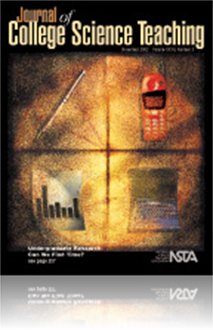All Resources
Journal Article
Fourth-grade students, their teachers, and a group of teachers-to-be explore environmental science through integrated learning phases. Students took a trip to a local creek, conducted science inquiry activities in the classroom, and created a multim...
Journal Article
Learn more about the life cycle of a virus and simulate the spread of a cold throughout your classroom. This article features a mini-unit developed around a theme that every student can relate to—the common cold....
Journal Article
Travel Without Leaving the Classroom
Create travel brochures that explore the flaura and fauna of different biomes to persuade travelers to pay a visit. In this project, students research and report on a particular biome. The final product is a magazine modeled after a travel magazine. ...
Journal Article
Detecting and Preventing Plagiarism: Helping students avoid the pitfalls of plagiarism
Once a student has plagiarized successfully, they are likely to try it repeatedly and before long their enthusiasm to learn has been robbed. Today’s technology-savvy students are finding it easy to plagiarize papers using the Internet. The author s...
Journal Article
Scope on the Skies: Winter viewing
This column focuses on astronomy throughout the year. This month’s issue gives information on the opportunities for observing our solar system during the winter months....
Journal Article
Physics Careers Web Site: Expanding College Women’s Perceptions of Physicists’ Lives and Work
Twenty college women used a Physics Careers Web site that aligned profiles of the college’s physics alumnae with the curriculum of introductory physics during an experimental version of the course. Twenty-one college women took a control course tha...
Journal Article
Computer science analogies can aid the understanding of gene expression, including the storage of genetic information on chromosomes and the fate of genes that are no longer used. Computer science analogies can also aid the understanding of species i...
Journal Article
Commentary: Finding Purpose—Reflecting Upon Curriculum and Assessment
An opinion piece about how the purpose of teaching plays a sginificant role in how lessons are received and valued. The challenge for teachers is to critically reflect upon the purpose of their curriculum and assessments, and most importantly share t...
Journal Article
Editor's Note - November/December 2002
Science and Children’s editor shares thoughts regarding the current issue....
Journal Article
Rubric for Content Classification
Are teaching strategies such as collaborative learning, student-centered classrooms, and guided inquiry always appropriate? How do we decide what topics to teach? The Rubric for Content Classification is a taxonomy of material covered in a general sc...
Journal Article
The author describes how she revised an environmental science workshop exploring the use of graphing tools and sensors at the last minute to meet the needs of elementary students, high school students, and adults. ...
Journal Article
Launch rockets to test the effect of design modifications on flight characteristics. As a culminating activity to a unit on motion, students design, build, and launch model rockets....
Journal Article
Designed for Successful Learning: Using multiple intelligence assessment in the science classroom
This article reports the results of a research study that assessed the multiple intelligences of high school students enrolled in physics courses. ...
Journal Article
Fourth-grade students explore the life cycle of the Painted Lady butterfly using an inexpensive butterfly observatory. This interdisciplinary unit incorporates various journaling and illustration techniques that develop students’ observation skills...
Journal Article
Inquiry through Portable Technology
Explore your world with the latest probes, sensors, and other pocket-size technology. ...
Journal Article
Science and Communication: Incorporating language arts instruction into science lessons
Good communication skills are essential to the success of every student. With minor adjustments science teachers can teach communication skills without sacrificing science content. The author suggests four ways to integrate language arts skills into...
Journal Article
Naturalist Writers and Environmental Sentiments
Develop students' awareness and appreciation for the world around them through the written word. Using the work of naturalist writers such as John Muir, Rachel Carson, or Henry David Thoreau offers a refreshing complement to science learning. Sample ...
Journal Article
Idea Bank: A Forgotten Resource
The Idea Bank provides tips and techniques for creative teaching, in about 1,000 words. This month’s Idea Bank focuses on the one educational resource often overlooked—guest speakers. They can offer an excellent insight into science and science c...
Journal Article
After the Bell: Newspaper science—Read all about it!
Newspapers that regularly feature science can be used to introduce students to current events. These resources can also lead the way to meeting the National Research Council's suggestions on helping to increase scientific literacy....
Journal Article
Minimizing Misconceptions: Tools for identifying patterns of reasoning
By distinguishing clear patterns of reasoning, teachers can face the long list of student misconceptions without feeling overwhelmed. This article offers chemistry teachers a useful tool that describes eight thinking rules and examples of alternative...






